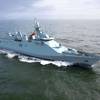This Day in U.S. Coast Guard History – December 10
1905-"To evaluate its use in lighthouse work, radio equipment was installed experimentally on Nantucket Lightship in August of 1901. On December 10, 1905, while riding out a severe gale, Lightship No. 58 on the Nantucket Shoals Station sprang a serious leak. There being no recognized radio distress signal at that time, the operator could only repeatedly spell out the word "help". Although no reply was received Newport Navy station (radio) intercepted the call and passed it on to the proper authorities. The lightship tender Azalea was dispatched to the assistance of Lightship No. 58, and upon arrival at the scene passed a towline. The long tow to a safe harbor began, but after a few hours it was quite evident that Lightship No. 58 was sinking. Azalea took off her crew of thirteen men only minutes before she sank. This pioneer use of radio had indeed proved Its worth in rescue operations."
1941-Germany and Italy declared war on the United States.
1981-A Coast Guard HH-52A landed on CGC Dependable's flight deck, marking the 5,000th helicopter landing on board the ship. According to AVTRACEN records, this was the most helicopter landings ever recorded aboard a cutter. The landing occurred off Dauphin Island in the Gulf of Mexico.
1993- Secretary of Transportation Andrew H. Card, Jr., awarded the military members of the Coast Guard the Humanitarian Service Medal and the civilian employees the Coast Guard Public Service Commendation for their services during the Haitian migrant crisis from October 1991 through November 1992. During that period, a flotilla of over 27 Coast Guard cutters rescued 35,000 Haitian migrants from hundreds of overcrowded and unseaworthy vessels.
1994- Due to budget constraints and White House efforts to "streamline" government operations, ADM J. William Kime, Commandant, issued an ALCOAST that announced an involuntary performance-based reduction-in-force of the active-duty enlisted work force in an effort to reduce the size of the enlisted force of the service.
(Source: USCG Historian’s Office)














